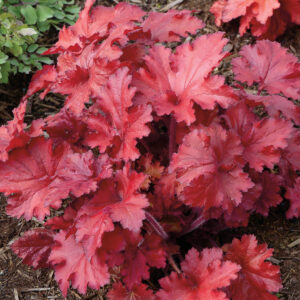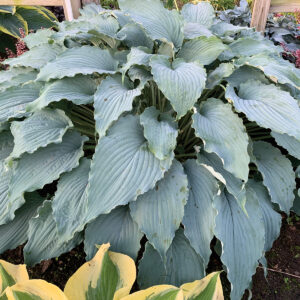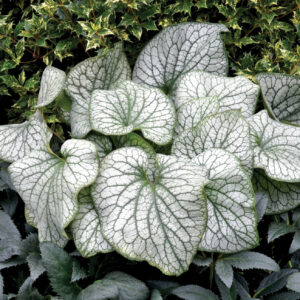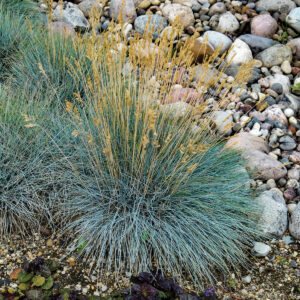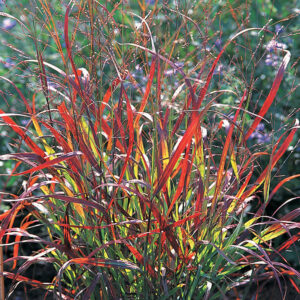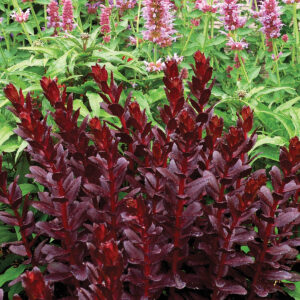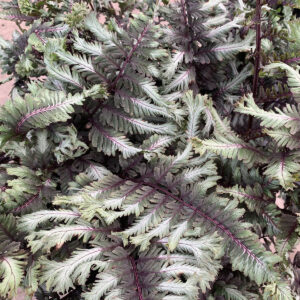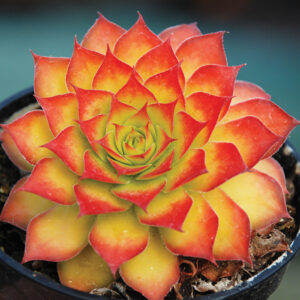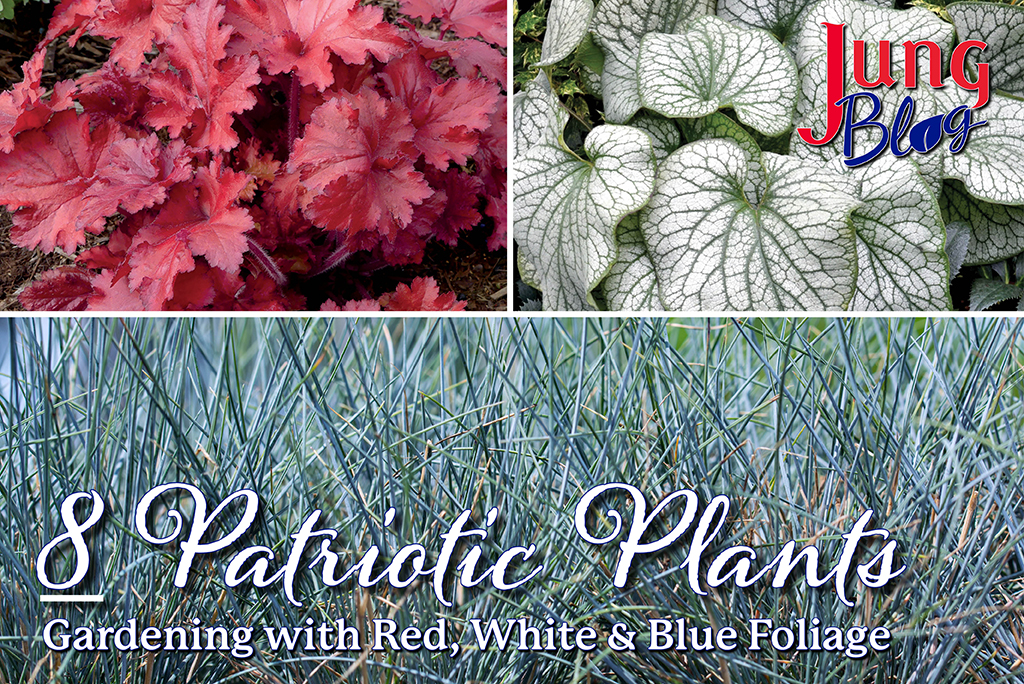
There are many ways to celebrate the 4th of July, from fireworks to parades. Many gardeners like to commemorate the holiday with red, white, and blue flowers. Another way to add patriotic colors to your garden is by growing plants with red, white, and blue leaves. Modern breeding has led to creating plant varieties with uniquely colored foliage, giving us even more options to add color to our gardens. Many of these plants can be used in shady landscape areas to make them brighter. Here are a few plants that will add a patriotic touch to your garden.
Forever Red Heuchera
Heucheras are excellent plants for both sun and shade. ‘Forever Red’ is known for its mound of bright red foliage. The leaf texture is scalloped and ruffled, creating an excellent combination of texture and color. In midsummer, white flowers emerge from the foliage and extend above the plant as though floating. The leaf color is brightest in the cooler weather of spring and fall. Heucheras have a variety of uses in the garden, and they’re ideal for gardens with limited space. You can plant them as a ground cover along the edges of a walkway or the front of a perennial border. They look great in containers as well. The common name for heuchera is coral bells.
Wind Beneath My Wings Hosta
Hosta comes in many sizes, shapes, and colors. ‘Wind Beneath My Wings’ is a grand variety with blue foliage. This variety has an elegant look as the plant matures to over 6 feet wide. The heart-shaped foliage contains ruffled edges that overlap to create a massive mound of foliage. Lavender-colored flowers are produced in midsummer, appearing on arching stems above the plant. You only need a few plants of this variety to cover a large area. Hostas are excellent plants for shady areas of the yard. They prefer moist soil but will tolerate drier soil. For the best effect, consider planting them in groups or as specimens.
Alexander’s Great Brunnera
One of my favorite perennials. It’s hard to miss the stunning foliage of brunnera. These small perennials produce mounds of silver foliage that stand out in the garden. ‘Alexander’s Great’ is an improved variety of the classic ‘Jack frost,’ featuring larger and longer leaves. The silver leaves have green veins running through them, adding to their unique look. The foliage emerges in spring, giving way to clusters of delicate blue flowers. Brunnera can be an excellent alternative to hosta in areas with deer, as the silver leaves possess a fuzzy texture that deer find unattractive. Brunnera is a superb addition to woodland gardens, borders, and near-water features. Brunnera is also called Siberian bugloss.
Elijah Blue Fescue
This blue fescue is perfect for difficult areas of the garden, thriving in dry and sunny sites where many plants struggle to grow. Once established, ‘Elijah Blue’ is drought tolerant and long-lived. The compact nature of this plant allows you to grow them near sidewalk edges and the front of borders. The distinct flowers emerge midsummer, creating additional interest for fall and winter. This species can be planted as a ground cover in small or large groups. You can combine it with other drought-tolerant perennials or try it in containers. Like most grasses, deer tend to avoid this plant.
Shenandoah Red Switch Grass
This native grass is perfect for adding summer and fall colors to the garden. The green foliage emerges in late spring, then turns dark red in midsummer before changing to wine red in early fall. ‘Shenandoah Red’ prefers full sun but will tolerate light shade. Along with striking foliage, this species has beautiful dainty flowers, which emerge in midsummer. The clumps of upright foliage are 3 feet tall and wide, making them ideal for small and large gardens. ‘Shenandoah Red’ can be grown in a variety of garden settings. A few examples include mass plantings, native gardens, and wet areas. Switchgrass thrives in soil that is moist but well-drained.
Touchdown Teak Sedum
Sedum is known for its fall flowers, but some varieties offer uniquely colored foliage. ‘Touchdown Teak’ features bright red stems that support red-brown to purple-brown foliage. Some sedums grow upright, while others creep along the ground. ‘Touchdown teak’ offers clumps of upright foliage that grow up to 20 inches tall. Some varieties of sedum are prone to flopping, but not ‘Touchdown Teak .’Like other sedums, this variety features beautiful flowers in late summer-fall. The rose-red blooms attract many types of pollinators and butterflies. Sedum prefers average, well-drained soil in full sun. Planting them in groups will give the foliage maximum visual impact.
Crested Surf Japanese Painted Fern
‘Crested Surf’ features dark stems and silver-toned leaves, creating a unique combination of colors that will stand out in the shade. This variety also has a unique texture, with fronds that are double crested and ruffled. Ferns are unusual plants that reproduce from spores, not flowers. These ancient-looking plants are perfect additions to moist and shady areas of the garden. They look perfect when planted near water features, like a stream or pond. You can also mix them with annuals in a container. ‘Crested Surf‘ forms clumps of foliage reaching 22 inches tall.
Gold Nugget Hens and Chicks
While not exclusively red, the foliage of ‘Gold Nugget’ features various colors during the year. In spring, the leaves are golden-yellow with bright red edges. Summer brings lime green leaves which eventually turn gold and red during fall. Hens and Chicks are small succulents that form mats on the ground. They frequently produce offspring known as chicks, which You can remove from the mother plant to create new plants. These small plants grow well in areas with sharp, draining soil and full sun. Many gardeners use them in gravel gardens, where you can mix them with other succulents or cacti. Hens and Chicks are ideal for container plantings.

As you celebrate Independence Day, take a moment to consider how you might add these patriotic colors to your garden. Happy 4th of July!
Other Recommended Reading
- Allium: Natural Fireworks For Your Garden
- 24 Flowers, Fruit, & Plants Perfect For Your Patriotic Garden
- Choosing The Best Pumpkin Varieties For Halloween
- Create A Mardi Gras Themed Garden
- Easy To Grow Salsa Garden
At Jung Seed Co, we strive to be your go-to guide for all your gardening needs. Our YouTube channel Jung Garden Center now includes our new video series All Things Green where our experts provide gardening tips for all levels of gardeners. When you need reliable gardening advice, turn to the trusted experts at Jung.
View our new catalog online or browse our website for all of your gardening favorites. To receive info on new products, exclusive deals, and specials, be sure to sign up for our weekly email. Join our Facebook page, to discuss all things gardening!
About the Author: Matthew Olson is a professional horticulturist and garden writer. He has a bachelor’s degree in horticulture from UW-River Falls and is a certified professional with the Minnesota Nursery and Landscape Association. His enthusiasm for plants and the outdoors brought him to the green industry. He regularly writes articles about gardening for both gardeners and industry professionals. He can be reached at matt@mattolsonhorticulture.com
